This article provides effective strategies and tools for quick and seamless translation of documents from Portuguese to English.
Portuguese, born in the Iberian Peninsula, flourishes as a global language with over 260 million speakers. Portuguese speakers live primarily in Portugal and Brazil. Its journey, enriched by diverse influences, spans centuries.
Modern tools offer efficient solutions for translating Portuguese to English PDFs. Online platforms like Google Translate or DeepL handle text translation. Meanwhile, tools such as PDFelement Pro manage PDF documents. Professional translators also provide expert help for nuanced or sensitive content. Whether for business, academic, or personal use, these methods can easily translate documents from Portuguese to English. Read on to learn more.

In this article
Part I. 5 Tools To Translate Portuguese to English PDFs
Various methods can streamline the process of translating Portuguese PDF documents into English. Each approach has advantages and disadvantages, from dedicated software to online tools. The section explores five effective methods for translating Portuguese to English PDFs. It will also discuss their pros and cons along with step-by-step instructions. Let’s start with using a dedicated tool:
Tool 1: Using a Dedicated Tool – Wondershare PDFelement
Wondershare PDFelement is a comprehensive PDF editing software that includes translation capabilities. Its straightforward interface and useful features make it a popular choice for managing PDF documents. What’s more, the platform is available on desktops and smartphones. Here are the steps to translate Portuguese PDFs to English using PDFelement.

Step 1: Begin by downloading and installing PDFelement on your computer. Once installed, open the application. Log in with your Wondershare, Google, Facebook, Twitter, or Microsoft account. Go to Open PDF and select the specific Portuguese PDF document you wish to translate.
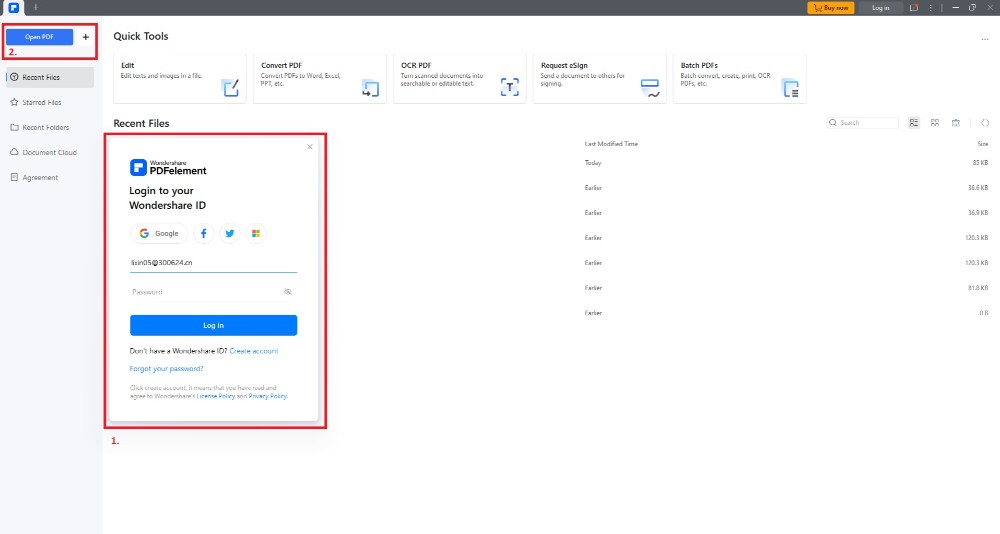
Step 2: Once the PDF is open, go to AI Tools > Translate PDF. Choose English as the target language and click Translate.
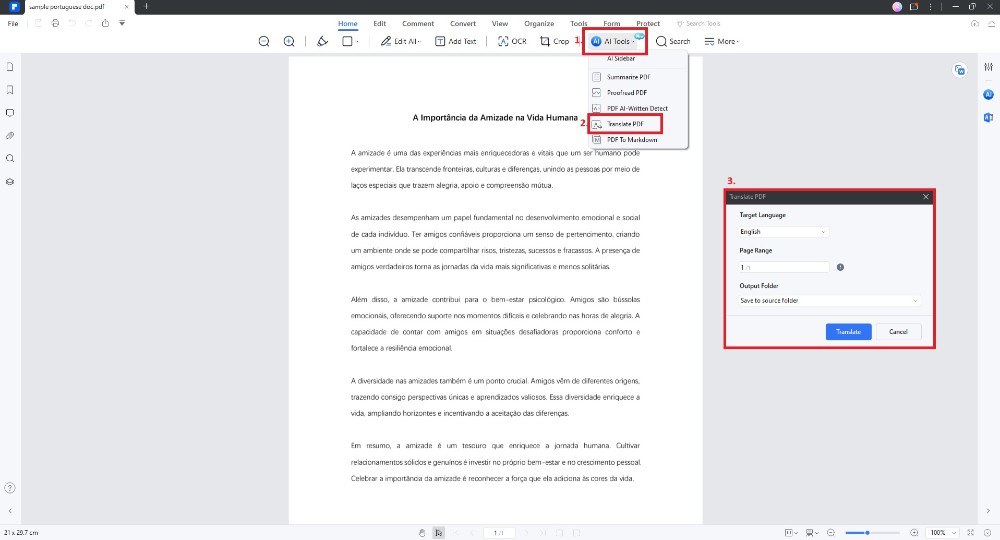
Step 3: Allow PDFelement’s AI to complete the translation. Afterward, review the translated PDF from Portuguese to English. If satisfied, click on File > Save As or Export To to save the translated PDF file in your preferred format.
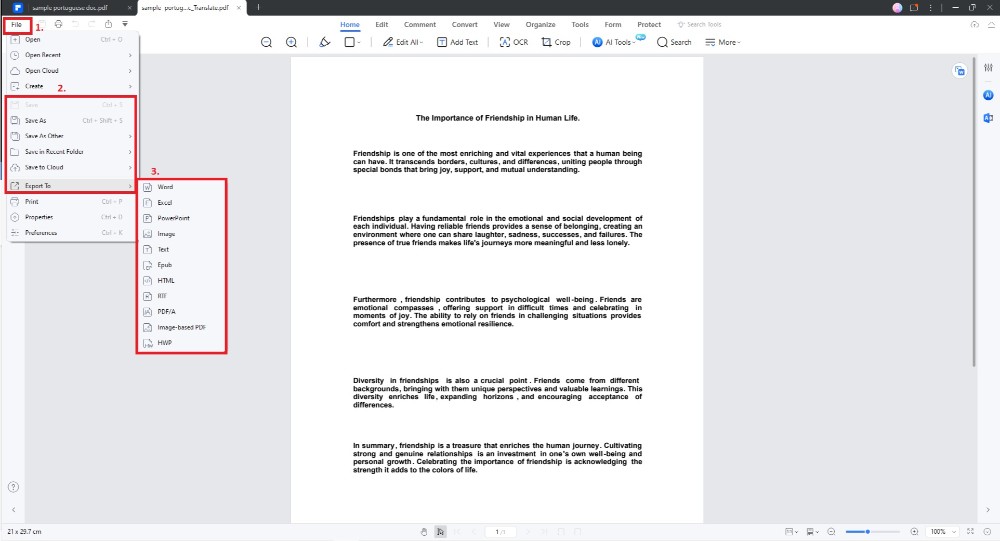
How To Translate Specific Text From Portuguese to English
If you only need to translate specific text from Portuguese to English, follow these steps:
Step 1: Launch PDFelement and open your PDF file. Copy the desired text and paste it onto the Translate icon on the interface’s right side. PDFelement’s AI will display the translation in the AI sidebar.
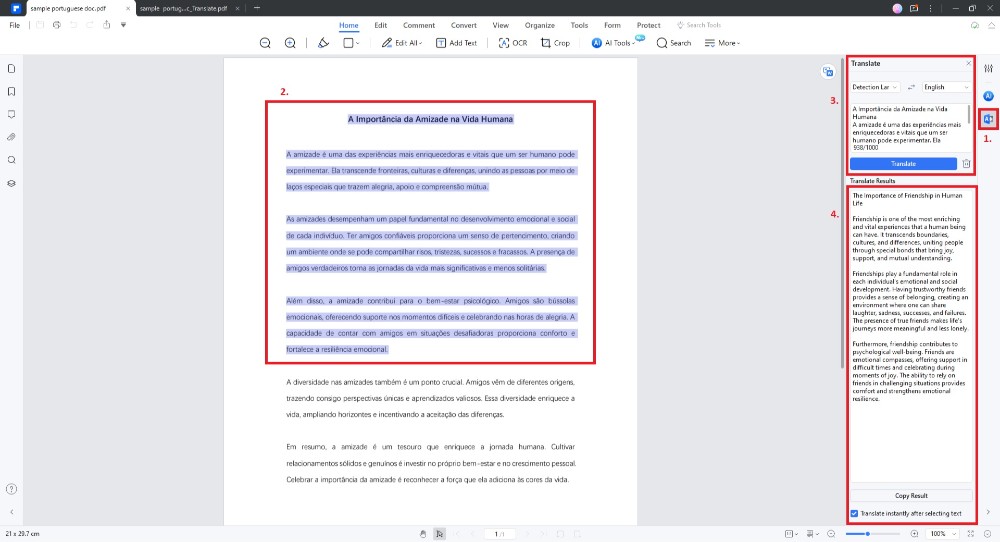
Step 2: Let PDFelement’s AI translate the selected Portuguese text to English. Once complete, save the file using the usual steps.
Note: If the document is not in PDF format, click the Create button to convert a PDF from the original document. This feature allows you to proceed with the translation steps.
Pros
Comprehensive editing features beyond translation
Ability to maintain formatting and layout of the original document
Can be used offline, ensuring privacy and security
Cons
Paid software requiring a one-time purchase or subscription
Translation quality may vary depending on the complexity of the document
Tool 2: Using an Online Tool – Google Translate
Google Translate is a widely used online translation tool. It offers quick and accessible solutions for converting text from one language to another. Follow the steps to use the tool for Portuguese to English translation:
Step 1: Visit the Google Translate website. Upload the Portuguese PDF document or copy and paste the text into the provided box.
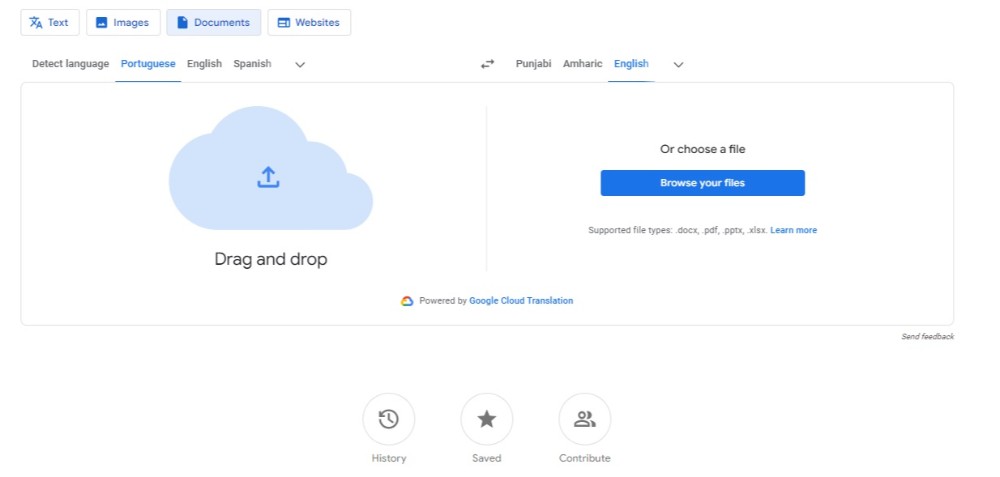
Step 2: Select Portuguese as the source language and English as the target language. Click on the Translate button to generate the English translation.
Pros
Free to use with no installation required
Provides instant translations with decent accuracy for simple texts
Supports a large number of languages, including Portuguese and English
Cons
May struggle with complex or technical language, leading to inaccuracies
Unable to preserve the original formatting of the PDF document at times
Tool 3: Alternative Online Tool – DeepL
DeepL is an online translation tool known for its advanced AI and natural language processing capabilities. It offers high-quality translations for various languages. Here are the steps to use DeepL for Portuguese to English translations:
Step 1: Visit the DeepL website. Click Translate files and upload the Portuguese PDF document, or copy and paste the text into the provided box.
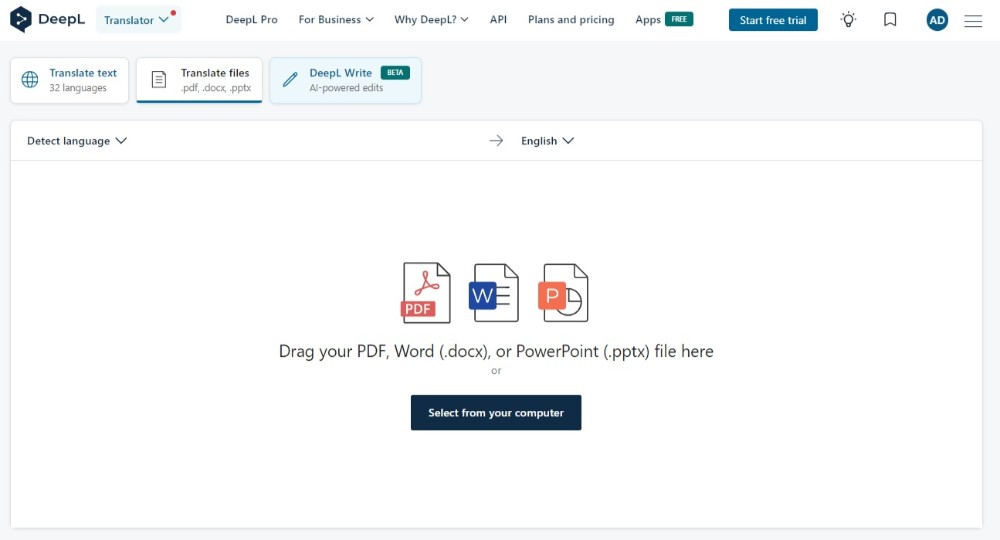
Step 2: Select Portuguese as the source language and English as the target language. Click the Translate into English button to start the translation process. Once done, review the translated file and save it on your computer.
Pros
Delivers more accurate translations compared to other online tools
Maintains the context and nuances of the original text
Offers a user-friendly interface with no ads or distractions
Cons
Limited language options compared to Google Translate
The free version has restrictions on the number of characters that can be translated at once
Tool 4: Using OCR Software – Adobe Acrobat Reader DC
Adobe Acrobat Reader DC is a versatile PDF reader. The platform includes optical character recognition (OCR) as an alternate way to translate PDFs. It allows you to convert scanned PDFs into editable and translatable text. Follow the steps:
Step 1: Open the Portuguese PDF document in Adobe Acrobat Reader DC. Click the Scan & OCR button and use the OCR feature to recognize text within the document.
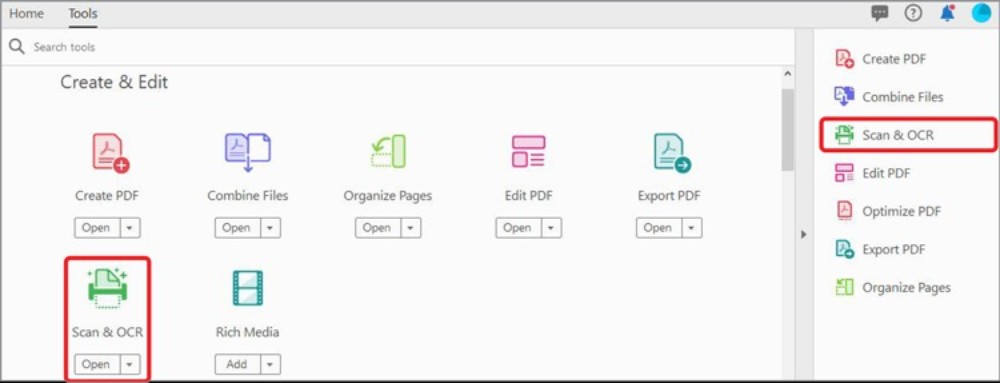
Step 2: Click the text element you wish to translate and paste it into a text editor or translation tool. Translate the text from Portuguese to English using the preferred method.
Pros
Capable of translating scanned PDFs and images with text
Provides editable text for more accurate translations
Integrates seamlessly with other Adobe products for enhanced functionality
Cons
Limited language options compared Requires a subscription for advanced OCR features
OCR accuracy may vary depending on the quality of the scanned document
Tool 5: Hiring a Professional Translator
For accurate translations, hiring a professional translator is often the best option. Look for professional translators with expertise in Portuguese and English. Hiring a person for the job instead of using tools is sometimes better for complex or sensitive documents.
Pros
Ensures accurate and culturally sensitive translations
Offers personalized attention and communication with the translator
Can handle complex documents with technical or specialized language
Cons
Typically more expensive compared to automated or online methods
Translation turnaround time may vary depending on the availability of the translator
Part 2. What To Look for in a Good Translation Tool
Selecting the right translation tool is crucial for accurate and efficient language conversion. With many options available, ensuring the chosen tool meets your specific needs is essential. Here are the characteristics of an ideal translation method:

Accuracy
Ensure the tool provides accurate translations without significant errors or mistranslations.
- PDFelement’s AI-powered translation uses advanced algorithms to deliver precise translations.
Language Support
Look for a tool that supports a wide range of languages. It should support both the source and target languages you need.
- Google Translate offers translation services for over 100 languages. These include Portuguese and English, ensuring comprehensive language coverage.
Ease of Use
Look for a user-friendly interface that simplifies the translation process. An easy-to-use app allows for seamless navigation and operation.
- DeepL provides an intuitive platform with a clean design. It’s easy for users to input text and get translations.
Speed
Choose a tool that delivers fast translation results. It’s especially important for time-sensitive documents or tasks.
- Online tools like Google Translate offer instant translations. It allows you to get results within seconds.
Additional Features
Look for extra features offered by your preferred method. Take advantage of offline translation capabilities. Use document formatting preservation or integration with other apps.
- PDFelement offers comprehensive PDF editing features alongside translation. It’s a versatile tool for document management and language conversion.
Conclusion
Exploring and trying various methods is key when translating documents from Portuguese to English. Each tool has its pros and cons, so it’s essential to consider your specific needs. While options like Google Translate offer convenience, PDFelement stands out with its comprehensive features. The app offers precise translation, document formatting preservation, and a user-friendly interface.
For efficient and accurate Portuguese-to-English document translation, consider PDFelement’s all-in-one solution. Nonetheless, explore the available methods for translating Portuguese to English PDFs to find the one that best suits your requirements.


